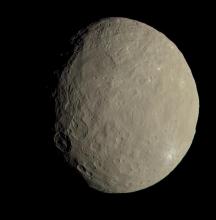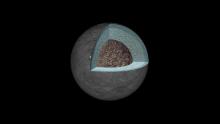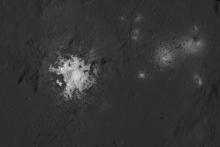Listen to today's episode of StarDate on the web the same day it airs in high-quality streaming audio without any extra ads or announcements. Choose a $8 one-month pass, or listen every day for a year for just $30.
You are here
Ceres
A big hole in the ground has helped scientists piece together the structure of the dwarf planet Ceres. It’s the largest member of the asteroid belt — about a quarter the size of the Moon. The hole shows that Ceres has layers, like a bigger planet or moon.
A spacecraft studied Ceres from orbit for three years. Its most impressive discovery was Occator Crater. It’s almost 60 miles wide and two miles deep. Big white blotches decorate its floor — deposits of salt.
Occator probably formed about 20 million years ago, when a space rock hit Ceres. Recent work suggests there was a layer of salty, muddy water about 30 miles below the site. The impact fractured the crust, allowing some of the brine to leak into the crater floor. The water evaporated, leaving the salt.
The crater also is marked by dozens of small rounded hills. They resemble features on Earth known as pingoes. They formed when water surged from below, pushing up the top layer of rocks and ice.
Occator Crater and other features reveal that Ceres has several layers. Two of those layers — the crust and mantle — are separated by a layer of muddy brine — which can sometimes leak onto the surface.
Ceres shines at its best for the year right now. It rises at sunset, is in view all night, and is brightest for the year. Through binoculars, it looks like a small, faint star to the lower left of the bright star Aldebaran as they climb into good view in the east by 9:30 or 10.
Script by Damond Benningfield





